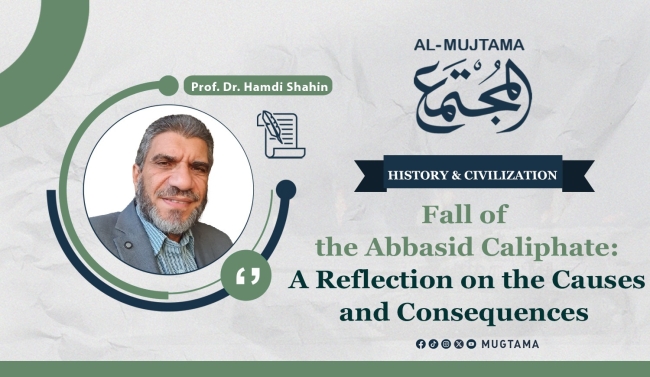During this period, when the Mongol threat against the East escalated, the Crusaders were trying to survive in the Levant, while the papacy was stoking the flames of its hatred towards Muslims, directed at both the Crusaders and the Mongols. Their power waned, their civilization withered, and the words of the Prophet Muhammad ﷺ were true regarding them.( The Prophet (ﷺ) said: The people will soon summon one another to attack you as people when eating invite others to share their dish. Someone asked: Will that be because of our small numbers at that time? He replied: No, you will be numerous at that time: but you will be scum and rubbish like that carried down by a torrent, and Allah will take fear of you from the breasts of your enemy and last enervation into your hearts. Someone asked: What is wahn (enervation). Messenger of Allah (ﷺ): He replied: Love of the world and dislike of death.) (Narrated by Ahmad and Abu Dawood).
The Mongol hurricane seemed an inevitable fate, one that nothing could stand against. They advanced upon the eastern lands of Islam, and the complacent rulers gave them the perfect opportunity. This was because the Abbasid Caliph Al-Nasir Li-Din Allah (575 - 622 AH) feared the threat posed by his adversary, Jalal ad-Din, the King of Khwarezm, who coveted the throne of Baghdad. Thus, Al-Nasir proposed to Genghis Khan, the King of the Mongols, that he attack the Khwarazmian dynasty from the east, while the caliph would attack them from the west!
It is true that Genghis Khan did not pay attention to the caliph's message, as he was protective of his trade relations with the Khwarazmian. However, the caliph's message opened the eyes of the Mongols to the deep divisions among the followers of Islam and the way some were waiting to take advantage of others!
Then a disagreement occurred between the Mongols and the Khwarazmian when some of their princes attacked a Mongolian caravan. Genghis Khan invaded the lands of Khwarazm and Khorasan in a fierce campaign, destroying its grand cities: Samarkand, Merv, Nishapur, Bukhara, Ghazni, and others, all within a single year (617 AH / 1220 AD).
Jalal al-Din, the King of Khwarazmshah, was killed in the year 628 AH, four years after the death of Genghis Khan. After him, Möngke Khan assumed power and appointed his brother Hulegu as the governor of the western part of his empire, assigning him the task of invading its neighboring territories. In the year 651 AH, Hulegu mobilized his army and subdued the fortified strongholds of the Ismailis, with the most impregnable of them being the fortress of "Alamut." He turned it into a flat wasteland in the year 554 AH, and then followed it up by seizing control of Anatolia, beginning to close in on the grand prize: Baghdad, the capital of the caliphate and the seat of the glory of Islam.
Things in the capital of the Caliphate were becoming increasingly weak when Caliph Al-Mustaʿṣim bi-llāh took over in the year 640 AH. He was a man "with a softness about him, a lack of alertness, and a love for wealth and amassing it." In the year 646 AH, a huge flood struck Baghdad, destroying some of its fortifications and causing harm to its residents, in addition to the suffering they were already enduring from exorbitant taxes and the decline of trade after the Mongols devastated cities and villages nearby. The people were also engulfed in civil strife and sectarian wars. In the year that Hulegu was mobilizing forces to attack Baghdad in 655 AH, a tumult arose between Sunnis and Shiites, which "led to great looting and destruction," and many Shiites were killed. The minister Ibn Al-Alqami, driven by this, took advantage of the situation to betray by colluding with the Mongols for their entry into Baghdad.
The political leadership was divided regarding the threat of the Mongols. While Mujahid al-Din al-Dawadar, the commander of the Sunni army, believed it was essential to fight, the shia minister Ibn al-Alqami was preparing the caliph to appease them by sending gifts and large sums of money to Hulegu and his followers. Meanwhile, the caliph himself was overwhelmed by illusions of strength—despite being devoid of it—so that when he received threatening letters from Hulegu , he would repeat: "Between me and Hulegu , there is a khan and his brother Möngke who are friends and allies, not enemies and adversaries." Numerous accounts have been narrated about the betrayal of Ibn al-Alqami and his sectarian machinations, indicating that he was the one who seduced the caliph and convinced him to dismiss most of his troops, removing them from the payroll, until only about ten thousand remained, in a state of "scarcity and ultimate humiliation," after they had been over one hundred thousand or more!
The policy of Hulegu favored fierce psychological warfare through destruction, burning, and genocide. News of this reached the ears of the people of Baghdad, increasing their terror. Some, in their folly, mistreated some of Hulegu's envoys to the caliph, which only added to his anger. The caliph sent a delegation to him, which included the jurist Ibn al-Jawzi’s grandson. The elder warned Hulegu of the consequences of his attack on Baghdad and offered to surrender its treasures in exchange for withdrawing from the siege. He conveyed the caliph's promise that he would mention Hulegu’s name and pray for him in the Friday sermons. However, Hulegu paid no attention to his words, resumed his march and preparations, and the caliph and his leaders did not notice the movements of the Mongols until their armies were 50 kilometers from Baghdad. Those armies had marched thousands of kilometers into Islamic territory without facing any resistance.
Baghdad did not fight a notable battle, except for the attempt by the commander Mujahid al-Din, which was quickly met with harsh resistance and dwindled away. The siege did not last long, as Hulegu rejected the gifts of the defeated and took pleasure in humiliating them. It surrendered after 6 days, and the dignitaries and nobles went out to meet Hulegu , who betrayed them and exterminated them.
Hulegu asked the caliph when he saw the abundance of his wealth: "If you know that gold cannot be eaten, why have you kept it and not distributed it among your soldiers, so that they may protect your inherited kingdom from the attacks of this invading army? And why did you not turn those iron doors into arrows and rush to the banks of the Jaxartes River to prevent my crossing?" The caliph replied: "This was God's decree." Hulegu responded: "What will happen to you is also God's decree."
Then Hulegu ordered the gathering of the caliph's harem, which consisted of 700 wives and concubines, and 1,000 female slaves. He ordered the imprisonment of the caliph and that food be denied to him. When Al-Mustaʿṣim requested something to eat, Hulegu sent him a plate containing gold and silver jewels, perhaps hoping he would eat them! Then he ordered his execution.
Baghdad was pillaged for 40 days, and all those who were captured from its people were killed, with estimates of their numbers ranging between 800,000 and 2 million souls!
The invaders followed the manifestations of civilization and eradicated them. The greatest catastrophe was the setting fire to the "House of Wisdom," the great library, and they threw the books into the Tigris and Euphrates, causing their waters to flow black from the ink.
The tragedy of the Muslims did not last long; within two years, the Mamluks of Islam in Egypt, led by Qutuz and Baybars, inflicted a great defeat on the Mongols at "Ain Jalut" in the year 658 AH. They revived the caliphate by pledging allegiance to another Abbasid caliph in Cairo, and the civilization of Islam continued in Egypt, the Levant, Morocco, and Al-Andalus. It would not be long before the Mongols themselves entered Islam, becoming a support for it and a part of its miracles.
As for the treacherous minister Ibn al-Alqami, the Mongols appointed him as a humiliated deputy in Baghdad. A Muslim woman saw him while he was riding his mount, and the Tatar soldiers were urging him to hurry, hitting his mount with sticks. The woman said to him, "Was this how the Abbasids treated you?!" He died a few months later in the same year that the Tatars entered Baghdad, in the year 656 AH. (In their stories there is truly a lesson for people of reason. This message cannot be a fabrication, rather ˹it is˺ a confirmation of previous revelation, a detailed explanation of all things, a guide, and a mercy for people of faith.) ( Yusuf :111)
_________________________________


